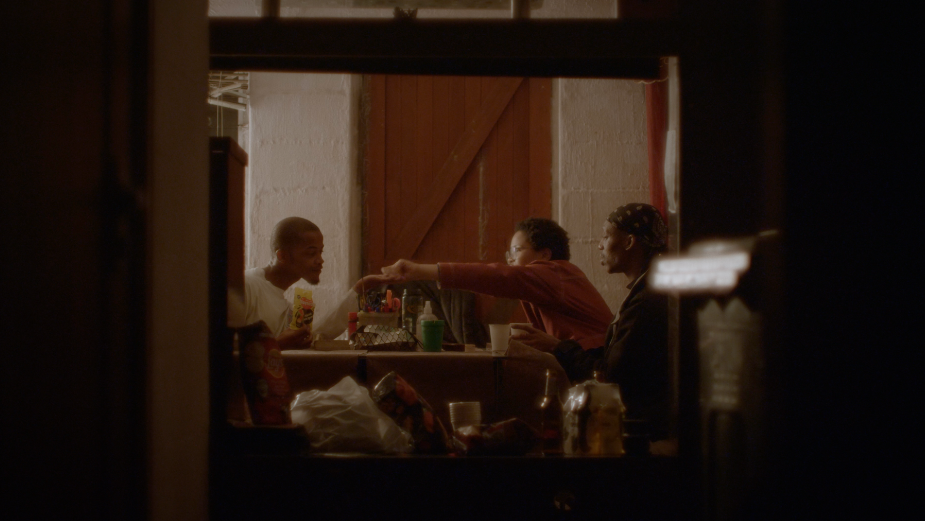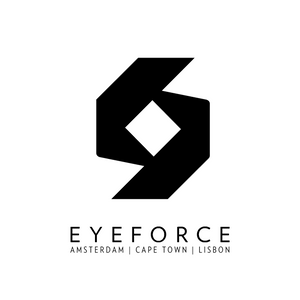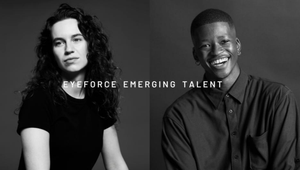
LBB Film Club: Langa Pride

In most places around the world, being a part of the queer community comes with risks. In the ‘Langa Pride’ short film, the topic of conversation travels to South Africa and the townships that hold silent but omnipresent communities of people who form part of the LGBTQIA+ contingent. To shine a light on the community and in an effort to encourage acceptance amongst people in the region, the film follows four brave participants as they attend the festivities of the first pride celebration in Langa township.
Across the short film directed by Eyeforce’s Alex Revers and the 'This Is A Beginning, Not The End' exhibition photographed by Vivian Camphuijsen, powerful representations of the Langa LGBTQIA+ community show how protagonists Fundi, Mbasa, Prince, and Sim are no longer silent about their authentic selves. Celebrating loudly and proudly, the topics of cultural practices, religious affiliation, and gender are explored to educate the local community and reduce the homophobic and transphobic responses that people may experience.
Speaking about the educational short film and the powerful accompanying portraits used to represent the occasion are Eyeforce’s director Alex Revers and photographer Vivian Camphuijsen.

LBB> Let’s begin with a little insight into the LGBTQ+ community in the townships of South Africa and why you wanted to shine a light on the topic in this short film.
Alex & Vivian> Queerness in the townships of South Africa is silent but omnipresent. With a history of violent attacks against the LGBTQIA+ community, most people have learned to retreat, hiding their authentic selves. They have faced homophobia and transphobia within their communities, magnified by the intersecting challenges in relation to cultural practices, race, gender, religious affiliation, income, and class. It has resulted in complex lenses of how individuals see themselves, form relationships, and interact with their communities.
This is on the verge of changing. For the last few years, mostly because of the presence of social media, it is becoming more difficult for the homophobic community to look away from queerness or for the queer community to look away from their sexual/gender identity. Queerness is slowly becoming an easier topic, especially for the younger generation.
As part of our research, we brought together a group of young individuals from Langa to give queer people a safe space to talk. This encounter evolved into a community organising the first-ever Langa Pride. When serendipity brought us and them together, we were determined to help them share their stories to inspire and educate others.
Although South Africa is known for having the most progressive legislative protections for LGBTQIA+ individuals in the continent, this has not stopped acts of violence, particularly in townships. In 2021 alone, at least 20 individuals were murdered because of their sexual orientation and gender identity across South Africa. Hate crimes against LGBTQIA+ are common, including such tactics as ‘corrective rape’ against biological females, beatings and stabbings, and even using queer dating apps to lure and attack individuals.
LBB> How did the first-ever Langa Pride event come about and what was it like to be in attendance?
Alex & Vivian> There were 15 young, brave individuals who did the Pride walk. Starting with a moment of silence with candles and songs to remember the ones they lost. The walk lasted for 20 minutes on the main street of Langa with a police escort to protect them if something happened. It was beautiful to witness and to see them being proud of themselves. However the community of Langa was not informed of their Pride walk, there were no spectators, and this was a huge step for them.
LBB> What are the hopes for next year’s Pride celebrations? How is Langa Pride working towards creating a more open communication stream in the community?
Alex> Langa Pride is focused on education about the reality of what it’s like to be queer in the environment of a South African township. School presentations, film screenings, and inspirational posters from the queer community aim to open everybody’s eyes to work towards a safer place for the community. How big or small the next pride is, is 100% up to them to decide. It is all about baby steps at the moment.

LBB> From a filmmaking perspective, what was the starting point of telling this story and what were some of the themes you were keen to touch on?
Alex> Going from omni-silent to proudly saying who they are. While doing a first-ever pride which makes it a historic document to create. This is not only important for their generation but for both previous and future generations, in South Africa and internationally. We want to be part of their mission and use our experience as storytellers to bring theirs across. Together with this group of amazing, brave, and beautiful young queers from Langa, we are creating a historical, beautiful representation that they can show to their family, friends, and community.
Through their personal portraits and interviews they share the most important topics like challenges in relation to cultural practices, religious affiliation, and gender. Our focus is on relaying an authentic picture of what it means to be queer in a township.
LBB> Can you talk us through some of the scenes and filmmaking techniques that you used?
Alex> Our conversations have always been intimate, which you can see in the way the cinematography is shown and how the images are shot. Filming up close and personal with a small team, including locals from Langa, and using limited lights to keep the authenticity as close to who they are.
LBB> Who is the narrating voice behind the spot and why were they the perfect choice?
Alex> The narrating voice is Fundi, one of the initiators of the group and a spokesperson in every sense of the word. An obvious and the only authentic choice to make.

LBB> And what about the faces we see in front of the camera? How did you find the people to take part and what was their energy like when you filmed?
Alex> At this moment the main characters of the film are Fundi, Mbasa, Prince, and Sim. We got to know them during the research phase we did before pride month in March of Cape Town. They opened up to us sharing their stories.
Together with them, we talked about how they would feel in making a film about them. Following them towards their first Pride and years to come. We agreed that it would be a collaboration and that they decide what good scenes would be for us to film using us as a tool to share their story. What we also agreed on is that they decide when it would be a good time to put the film into the world to inspire others.
The exhibition in Amsterdam is called 'This Is A Beginning, Not The End' for good reason. We perceive this as the public launch of the movement, but we’re only getting started. The focus for now is to create work and momentum to educate their community about being queer. Whether those are workshops in school or organising a film screening for their families and friends. The process has humbled me, not trying to rush things and being respectful of their personal journeys.
LBB> How did lighting and camera equipment play a role in creating the spot?
Alex> We filmed with a RED while using old prime Nikon lenses with a lot of character in them. Unfortunately renting gear to film in a township is a challenge. A township in South Africa is a high-risk area - meaning gear is not insured - which makes it impossible to rent anything. Even though it is not the best camera to shoot a documentary on, we were blessed that Eyeforce Cape Town had a RED lying around with a beautiful set of old Nikon lenses for us to use. We brought our own vintage set of Leica lenses but could not find the right mount in Capetown to apply them for the RED.
The high-risk location came with another challenge: we could not hire a sound engineer, so we had to do sound with lapel mics and a shotgun mic. Obviously, not as one would want to approach filming but such circumstances are also what makes documentary work exciting.
With lighting, we used natural light as much as we could with two light tubes to fill in where it was necessary. Overall, we worked with a small set-up and an even smaller team to keep the setting intimate and not too overwhelming.
LBB> Why were you keen to incorporate elements of both film and photography within the project and how did you combine them to create a cohesive narrative?
Vivian> We’ve always had conversations on how film and photography could enhance one another, especially when the filmmaker and photographer are not from the same discipline [Alex is documentary and Vivian is conceptual]. Within this project, we believe we found the spark we were looking for.
Alex has a strong vision in capturing the story of a person in the now, the true story, and the vulnerability. He is able to straight away touch the emotional spark of the viewer. When you combine that with Vivian’s photography, a person becomes more layered. It’s like meeting a person at first: you get a vibe in the first three seconds but once you get to know them better, you understand why they present themselves in the way they do.
My objective was to show how we conceived this group when we first met them, in which we saw strong charisma, energy, love, and positivity. But behind that, there is a layer of pain. We are asking the viewer to look deeper than the first layer you see on the image, which almost conveys a sense of happiness. But once you see the documentary and get to know the characters, the photography suddenly shows a deeper layer to it, and you start seeing symbolism in the work. In the black and white image, for instance, you see a strong image at first glance but once combined with the film, the viewer will start asking questions about why is this umbrella covering faces. Is it because of fear, is it because these boys don’t want to be seen? The other way around, the film also gets a more vibrant note to the person if you see the images next to it.

LBB> In terms of the photography, you mention the notion of duality between the anonymous lives of people in Langa and their vibrant personalities. Can you tell us about some of the techniques you used to showcase the opposing emotions?
Vivian> Their vibrant personalities are one of the main objectives I’ve tried to show. I’ve used colours, contrast, and posing to convey this story. The duality is shown by using symbolisms such as an umbrella (making it anonymous) or the colour green (which stands for hope, the longing for balance). Shadows also show a sense of anonymity.
LBB> How did each person's personality play a role in their portraits and what was it like to style them?
Vivian> We have worked both on the streets of Langa which focuses more on anonymity and struggles, but we also created a safe space, which I refer to as ‘the box of safety’. A safe space where no filters are needed to be exactly who you are as a person. These are the images with a more styled (studio look) character to them. Together with Chris Auret, a talented painter from Cape Town, we sat down and talked about the journeys and the deepest longings and fears of the main characters. This resulted in artworks based on these conversations to serve as a backdrop for the images that represented the person that I would be photographing. My main goal was to create something with them, something that truly mirrored their own self without any opinions from the outside world. They were finally able to lose their filter and fear and could be themselves without judgement.
LBB> You mention there being plenty of colours in the world - can you share the role that colour played in both the filmmaking and the photography?
Alex & Vivian> For photography, the colours are more symbolic than anything else. The bright colours are a way of conceiving a more energetic vibe to the images. And with the film, the colour comes from the beauty of the characters. Who they are and what they stand for are the most vibrant colours on the screen.
LBB> What would you like viewers to take away from the film and the images?
Alex & Vivian> We hope people who hear this story feel as humbled and inspired as we feel while collaborating with this community. They radiate so much love and have overcome challenges that we can hardly imagine. Thus, we invite you to follow @group_ofcoolqueers on Instagram and give them the love and respect that they deserve. If you’re interested in any of these pictures as works of art on your wall, you can reach out to info@eyeforce.nl for more information. The same goes for any other form of support or ideas to grow the movement.










